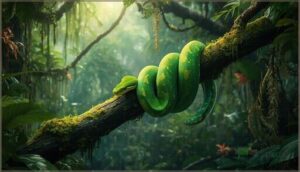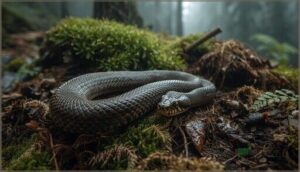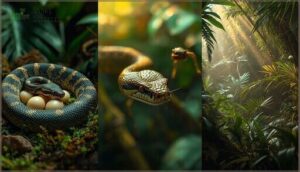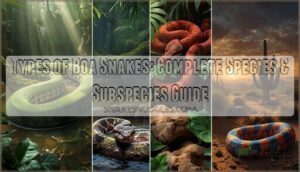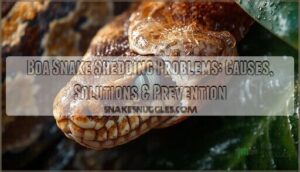This site is supported by our readers. We may earn a commission, at no cost to you, if you purchase through links.

A boa can thrive in a rainforest canopy or burrow beneath desert stones, yet every species carves its own niche with striking precision. Some stretch longer than a grown man, while others coil discreetly in your palm. Their colors range from emerald green to copper-bronze, patterns flickering like sunlight through leaves.
These differences aren’t just cosmetic—they shape how each boa hunts, breeds, and survives. If you’re curious about what sets the emerald tree boa apart from the rubber boa, or how island species rewrite the rulebook on adaptation, understanding different boa species characteristics reveals a world of evolutionary ingenuity waiting to be explored.
Table Of Contents
Key Takeaways
- Boa species span 60–70 types across multiple genera, each shaped by distinct geographic ranges—from Central and South American rainforests to Caribbean islands and North American temperate zones—where isolation and habitat diversity drive unique physical traits, hunting strategies, and reproductive adaptations.
- Physical differences among boas aren’t just cosmetic: size ranges from 60 cm to over 4 meters, arboreal species use prehensile tails and heat-sensing labial pits for canopy hunting, while terrestrial boas rely on muscular bodies for burrowing and ambush tactics that can exert constriction pressure up to 2.5 times their prey’s mass.
- Live birth (ovoviviparity) with gestation periods of 5.5 to 6.5 months distinguishes boas from egg-laying pythons, and dietary specialization varies widely—emerald tree boas target birds and lizards in canopies, while island species adapt to smaller prey, reflecting how evolution fine-tunes feeding strategies to match available resources.
- Conservation threats including habitat loss, climate change, and the pet trade push some boa populations toward endangered status, yet captive breeding programs that prioritize genetic diversity and legal protections offer critical lifelines for species survival across fragmented ecosystems.
Boa Species Taxonomy and Classification
Understanding boa taxonomy starts with knowing how scientists group these snakes and what sets them apart from similar species. You’ll see how their family tree branches into distinct genera and species.
Let’s look at the main ways experts classify boas and what makes each group unique.
The Boidae Family Overview
The Boidae family is a tapestry of snake species, each woven with unique traits. You’ll find:
- Boidae Taxonomy reveals 60–70 species across 8–10 genera.
- Constrictor Mechanisms define their non-venomous hunting style.
- Genera Diversity and Sensory Systems highlight adaptations from forests to deserts.
Conservation Status varies, so understanding their taxonomy deepens your appreciation and stewardship. Studying these creatures also highlights the importance of environmental concerns and conservation efforts.
Differences Between Boas and Pythons
Understanding Taxonomic Divisions reveals sharp differences between boas and pythons. Boas (Boidae) give live birth, while most pythons lay eggs—a clear split in Reproductive Modes. Their Hunting Tactics also contrast, with boas favoring maneuverability and some arboreal skills.
Color Patterns reflect habitat, and Conservation Status varies, shaped by habitat loss and distinct evolutionary paths across snake species.
Websites use marketing and other cookies to track visitor behavior.
Major Genera and Species Groups
You’ve seen how boas and pythons split on reproduction—now, let’s look closer at boa taxonomy and classification. Genus Classification sorts boa species into groups like Boa constrictor, Emerald Tree Boa, and Rubber Boa. Species Identification hinges on pattern, size, and habitat.
Phylogenetic Analysis and Molecular Studies continually prompt Taxonomic Revision, revealing the rich diversity among different species of boas.
How Scientists Classify Boa Species
Building on boa taxonomy and classification, scientists use morphological characteristics—like skull structure and scale counts—alongside molecular data to clarify species classification.
Geographic distribution and reproductive mode also shape how boa species are sorted, especially in Boidae.
Taxonomic revisions often arise as genetic studies reveal hidden diversity, refining Boa constrictor classification and expanding your understanding of species classification.
Geographic Distribution of Boa Species
Boa species turn up in some surprising places, from lush rainforests to dry deserts. Their range stretches across continents and islands, each home shaping unique traits.
Here’s where you’ll find them and how their habitats set the stage for survival.
Central and South American Boas
Did you know taxonomic revisions have reshaped how we view Central and South American boa species? From the rainforests of Panama to the savannas of Brazil, boa constrictors display striking pattern variation and activity patterns.
Habitat fragmentation drives juvenile mortality, while each species adapts uniquely to its environment—proving that boa species habitats are as diverse as their evolutionary stories.
Caribbean Island Boas
Imagine exploring the tropics and discovering Caribbean snakes clinging to palm branches—these island species tell a fascinating story of Island Boa Taxonomy and habitat specificity.
Distinct size dimorphism shines among populations, with habitat shaping everything from coloration to hunting style.
Tight conservation status reflects their fragile range, underscoring unique adaptations critical for survival. Every island’s boa weaves its own tale.
North American and Madagascar Boas
Across two continents, North American snakes and Madagascar snakes each demonstrate how habitat diversity and geographic isolation drive species adaptation.
North American boas generally favor terrestrial settings, their sturdy snake morphology built for varied climates, while Madagascar’s boas illustrate a mosaic of forms and ecological roles.
Boa conservation here demands specific strategies—each population reflects its own evolutionary path and conservation challenge.
Habitat Types and Environmental Adaptations
You’ll notice boas aren’t one-size-fits-all. From arboreal adaptations that let them flow through rainforest canopies to desert survival tactics like nocturnal hunting, their environmental adaptations map precisely to their habitat.
In temperate regions, hibernation is key, while island dwarfism and wetland foraging reveal just how much geographic distribution shapes every boa’s unique approach to survival.
Physical and Behavioral Characteristics
Boa species show a wide range of physical and behavioral traits shaped by their environments. From body size to hunting techniques, each type brings something unique to the table.
Here’s what you’ll want to know about their main characteristics.
Size Range and Body Structure
Ever wondered how different boa species stack up in size? You’ll find boas ranging from a modest 60 cm to giants over 4 meters, with females often outgrowing males—classic sexual dimorphism.
Trunk robustness and tail morphology vary widely, while scale morphology and ventral scales help define each boa’s body structure. These characteristics shape their unique ecological roles.
Coloration and Pattern Variations
Did you know boa color morphs aren’t just for show? Pattern genetics shape everything from the emerald tree boa’s vibrant green to the rainbow boa’s iridescence effects.
Adaptive coloration and camouflage strategies help boas blend in, whether they’re sporting high-contrast saddle marks or muted color variants.
These coloration and pattern variations reflect evolutionary responses to habitat and predation pressures.
Arboreal Vs. Terrestrial Adaptations
Patterns aren’t the whole story—arboreal boas rely on prehensile tails for climbing, while terrestrial boas use muscular bodies for burrowing. Camouflage differences emerge: canopy dwellers display bold, elevated saddle patterns, while ground species favor darker, leaf-mimicking hues.
Think about these three contrasts:
- Climbing vs. Burrowing
- Camouflage Patterns
- Dietary Specializations shaped by habitat pressures
Hunting Strategies and Constriction Methods
Shifting from burrowing and climbing, you’ll see boas rely on ambush tactics, blending into ground cover or perched branches. Most hunts use visual cues, with constriction pressure reaching up to 2.5 times the prey’s mass—subdue duration often falls between 12 and 42 seconds.
Seasonal hunting shifts with prey movement, making their strategies a finely tuned balance of patience and power.
Heat Sensing and Sensory Adaptations
While boa constrictors rely mainly on vision, other boas use specialized morphological adaptations like labial pits, packed with pit microvasculature and TRP channels, to sense heat.
This thermal acuity allows them to track prey in darkness. Neural integration of these signals, facilitated by boid evolution, reveals the intricate relationship between habitat, morphology, and evolutionary adaptation.
Iconic and Unique Boa Species
Some boa species stand out for their striking adaptations and impressive appearances. Each one brings its own story to snake habitats.
Here’s a look at a few that truly set themselves apart.
Boa Constrictor and Its Subspecies
Ever wondered how Subspecies Variation shapes the legendary Boa constrictor? You’ll find distinct Boa genetics across Central, South America, and the Caribbean, each adapting to local habitats. Constrictor behavior is a marvel of evolution, yet habitat fragmentation threatens some populations. Conservation status varies, so your understanding of Boa constrictor identification and ecology matters more than ever.
- Caribbean island forms endangered
- Regional population declines
- Unique color patterns by habitat
- Live birth, solitary hunters
Emerald Tree Boa
Emerald tree boas are the masters of arboreal adaptations, thriving in the dense rainforest canopies of the Amazon Habitat. Their emerald green, cryptic coloration lets them blend seamlessly while practicing precise canopy hunting.
You’ll notice females outsize males, using their slender bodies to ambush prey.
Conservation status depends on habitat stability—deforestation threatens this extraordinary boa species’ survival in its arboreal habitat.
Rubber Boa
Burrowing Adaptations set the Rubber Boa apart among boa species, thriving in cool, moist habitats across the western U.S. and Canada. You’ll find their smooth scales, thermal regulation strategies, and fragmented genetic clades reveal how different species of boas master local environments. Habitat threats persist, so understanding lifecycle variations is key for preserving these unique boa habitats and environments.
- Burrowing Adaptations
- Thermal Regulation
- Genetic Clades
- Lifecycle Variations
Rainbow Boa
Light refracted across the Brazilian Rainbow Boa’s iridescent scales creates a spectacle you won’t forget. These boas thrive in humid, forested Rainbow Boa habitats, using their reddish-brown color patterns for snake camouflage.
As nocturnal hunters, their boa behavior includes pursuing birds and rodents.
Conservation efforts matter—rainbow boas, unlike the boa constrictor, face habitat threats that demand your attention.
Island and Dwarf Boa Species
Picture a Saint Lucia Boa coiled in leaf litter, its size shaped by Island Dwarfism. On fragmented islands, Dwarf Boa species like the Dominican Clouded Boa show striking arboreal adaptations and compact bodies.
Habitat fragmentation threatens their genetic diversity and conservation status, making each population a living mosaic of evolutionary ingenuity within the broader tapestry of Boa species.
Habitat fragmentation endangers boa genetic diversity, turning each isolated population into a unique showcase of evolutionary adaptation and conservation challenge
Reproduction, Diet, and Conservation
Understanding how boas reproduce, what they eat, and the challenges they face is key to caring for them responsibly. Each species brings its own needs and quirks to the table.
Let’s look at the specific enclosure options that help meet those requirements.
Live Birth and Reproductive Behaviors
Ever wondered how boas bring their young into the world? Most practice live birth, showing ovoviviparity with gestation periods of 5.5 to 6.5 months. Maternal care can include warmth and rare post-birth guarding.
Litter sizes range from 6 to 40, often timed with seasonal breeding cues, which boosts neonate survival when prey and shelter are abundant.
Dietary Differences Among Species
Think all boas eat the same way? Not even close, and that’s what makes their feeding habits so fascinating. Prey specialization and dietary adaptations set each species apart. Depending on where they live or their size, you’ll find:
- Emerald tree boas hunting birds or lizards,
- Island boas adapting to small prey,
- Ontogenetic shifts favoring invertebrates in juveniles,
- Boa constrictors embracing a broad diet.
Lifespan and Growth Patterns
You’ve seen how diet shapes each boa’s life—now look at their pace of growth and longevity. Juvenile boas sprint through early growth rates, reaching maturity in just a few years.
Their lifespan hinges on a balance between fast juvenile growth and survival trends. With the right environment, some boa species can push their age metrics well past 20 years.
Conservation Status and Threats
Boa species face a range of conservation threats. Here’s what’s pressuring their survival:
- Habitat loss and fragmentation reshape rainforests and wetlands.
- Invasive species and the pet trade put endemic boas at risk.
- Climate impacts alter breeding patterns and survival rates.
- Sparse population monitoring means declines often go unnoticed.
Understanding these pressures helps reveal why some species now count as endangered.
Captive Breeding and Protection Efforts
When wild populations falter, captive breeding programs step up, blending genetic diversity with sophisticated breeding techniques. Institutions weave habitat enrichment and policy impacts into their daily routines, tracking lineage and health.
Community engagement and legal protections shape public attitudes, while snake breeding programs document conservation efforts.
These strategies, in tandem, help safeguard species and maintain wild-type traits across generations, supporting long-term survival.
Frequently Asked Questions (FAQs)
How do boas interact with other wildlife?
Like threads in a rainforest tapestry, boas shape ecosystems through prey interactions, habitat cohabitation, and defensive behaviors. Their role as predators influences wildlife dynamics, while conservation impact and ecosystem roles highlight their importance within complex habitats and food webs.
What role do boas play in ecosystems?
You’ll find boas at the heart of ecosystems, shaping community structure through trophic cascades and niche differentiation.
Their predation offers pest control, regulates rodent populations, and aids nutrient cycling, making them essential predators and contributors to wildlife balance.
Can boas be safely kept as pets?
You can keep boas as exotic pets if you understand space requirements, enclosure needs, and temperament concerns.
Legal restrictions and ethical considerations also matter—responsible pet ownership means prioritizing snake care and Boa pet safety above convenience or impulse.
How do boas respond to environmental changes?
Boas adjust quickly to climate variability and resource shifts, using behavioral plasticity and microhabitat changes to manage temperature tolerance and prey scarcity.
Their reproductive timing and evolutionary adaptation help them survive habitat loss, though climate change threatens long-term conservation efforts.
Are boa snakes affected by climate change?
Yes—climate change disrupts boa species through range shifts, altered breeding cycles, and juvenile survival declines. Rising thermal stress, prey density fluctuations, and habitat loss combine to threaten geographic distribution, demanding urgent conservation action.
Conclusion
What unites a palm-sized rubber boa with a six-foot emerald giant? Understanding different boa species characteristics reveals that diversity isn’t random—it’s evolution’s response to countless ecological challenges.
You’ve seen how taxonomy, geography, and adaptation intertwine to create snakes that thrive in deserts, canopies, and islands alike. Armed with this knowledge, you can appreciate each species not as curiosities, but as masterworks of survival shaped by millions of years of pressure and innovation.




